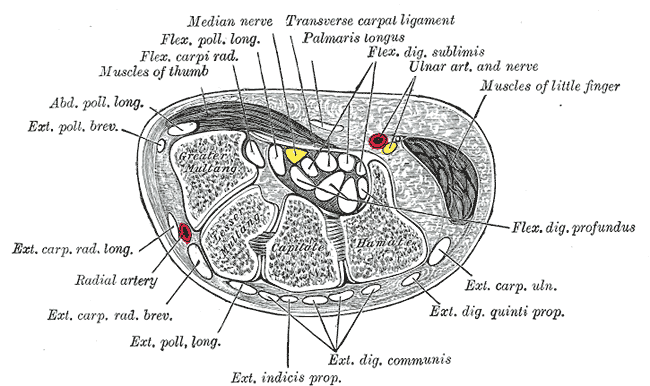 It affects mainly older individuals, and is associated with obesity, hypothyroidism, diabetes, pregnancy, family history, rheumatoid arthritis, and wrist shape. In spite of common feelings otherwise, there is very limited relation between work-related repetitive motion and carpal tunnel syndrome. The cause of the syndrome is a compression of the carpal tunnel, causing an impingement on the median nerve of the wrist. This causes pain or numbness in the fingers and thumb. The carpal tunnel release procedure involves reducing this impingement by cutting the carpal ligament. Then, after removing any enlarged tissue surrounding the median nerve, the carpal ligament is lengthened and reattached. The surgery is done on an outpatient basis and usually usually takes about a week of rest before beginning a rehabilitation program to regain muscle control. Results are usually very good, with complete reduction of pain and full mobility retained. This is one of the most common procedures performed by orthopedic surgeons in the United States.
It affects mainly older individuals, and is associated with obesity, hypothyroidism, diabetes, pregnancy, family history, rheumatoid arthritis, and wrist shape. In spite of common feelings otherwise, there is very limited relation between work-related repetitive motion and carpal tunnel syndrome. The cause of the syndrome is a compression of the carpal tunnel, causing an impingement on the median nerve of the wrist. This causes pain or numbness in the fingers and thumb. The carpal tunnel release procedure involves reducing this impingement by cutting the carpal ligament. Then, after removing any enlarged tissue surrounding the median nerve, the carpal ligament is lengthened and reattached. The surgery is done on an outpatient basis and usually usually takes about a week of rest before beginning a rehabilitation program to regain muscle control. Results are usually very good, with complete reduction of pain and full mobility retained. This is one of the most common procedures performed by orthopedic surgeons in the United States.
4/3/09
Procedure Profile: Carpal Tunnel Release
Carpal tunnel syndrome is fairly common in our population today.  It affects mainly older individuals, and is associated with obesity, hypothyroidism, diabetes, pregnancy, family history, rheumatoid arthritis, and wrist shape. In spite of common feelings otherwise, there is very limited relation between work-related repetitive motion and carpal tunnel syndrome. The cause of the syndrome is a compression of the carpal tunnel, causing an impingement on the median nerve of the wrist. This causes pain or numbness in the fingers and thumb. The carpal tunnel release procedure involves reducing this impingement by cutting the carpal ligament. Then, after removing any enlarged tissue surrounding the median nerve, the carpal ligament is lengthened and reattached. The surgery is done on an outpatient basis and usually usually takes about a week of rest before beginning a rehabilitation program to regain muscle control. Results are usually very good, with complete reduction of pain and full mobility retained. This is one of the most common procedures performed by orthopedic surgeons in the United States.
It affects mainly older individuals, and is associated with obesity, hypothyroidism, diabetes, pregnancy, family history, rheumatoid arthritis, and wrist shape. In spite of common feelings otherwise, there is very limited relation between work-related repetitive motion and carpal tunnel syndrome. The cause of the syndrome is a compression of the carpal tunnel, causing an impingement on the median nerve of the wrist. This causes pain or numbness in the fingers and thumb. The carpal tunnel release procedure involves reducing this impingement by cutting the carpal ligament. Then, after removing any enlarged tissue surrounding the median nerve, the carpal ligament is lengthened and reattached. The surgery is done on an outpatient basis and usually usually takes about a week of rest before beginning a rehabilitation program to regain muscle control. Results are usually very good, with complete reduction of pain and full mobility retained. This is one of the most common procedures performed by orthopedic surgeons in the United States.
 It affects mainly older individuals, and is associated with obesity, hypothyroidism, diabetes, pregnancy, family history, rheumatoid arthritis, and wrist shape. In spite of common feelings otherwise, there is very limited relation between work-related repetitive motion and carpal tunnel syndrome. The cause of the syndrome is a compression of the carpal tunnel, causing an impingement on the median nerve of the wrist. This causes pain or numbness in the fingers and thumb. The carpal tunnel release procedure involves reducing this impingement by cutting the carpal ligament. Then, after removing any enlarged tissue surrounding the median nerve, the carpal ligament is lengthened and reattached. The surgery is done on an outpatient basis and usually usually takes about a week of rest before beginning a rehabilitation program to regain muscle control. Results are usually very good, with complete reduction of pain and full mobility retained. This is one of the most common procedures performed by orthopedic surgeons in the United States.
It affects mainly older individuals, and is associated with obesity, hypothyroidism, diabetes, pregnancy, family history, rheumatoid arthritis, and wrist shape. In spite of common feelings otherwise, there is very limited relation between work-related repetitive motion and carpal tunnel syndrome. The cause of the syndrome is a compression of the carpal tunnel, causing an impingement on the median nerve of the wrist. This causes pain or numbness in the fingers and thumb. The carpal tunnel release procedure involves reducing this impingement by cutting the carpal ligament. Then, after removing any enlarged tissue surrounding the median nerve, the carpal ligament is lengthened and reattached. The surgery is done on an outpatient basis and usually usually takes about a week of rest before beginning a rehabilitation program to regain muscle control. Results are usually very good, with complete reduction of pain and full mobility retained. This is one of the most common procedures performed by orthopedic surgeons in the United States.
Subscribe to:
Post Comments (Atom)


No comments:
Post a Comment